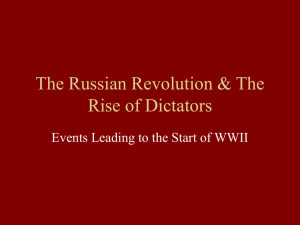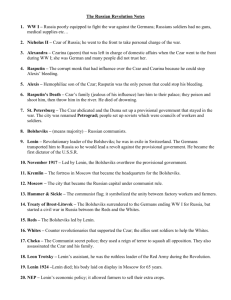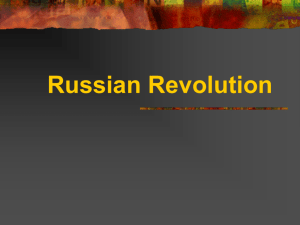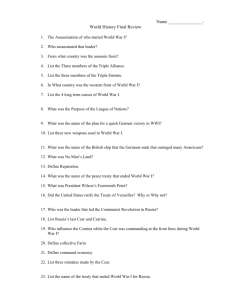Ch 30 Notes
advertisement
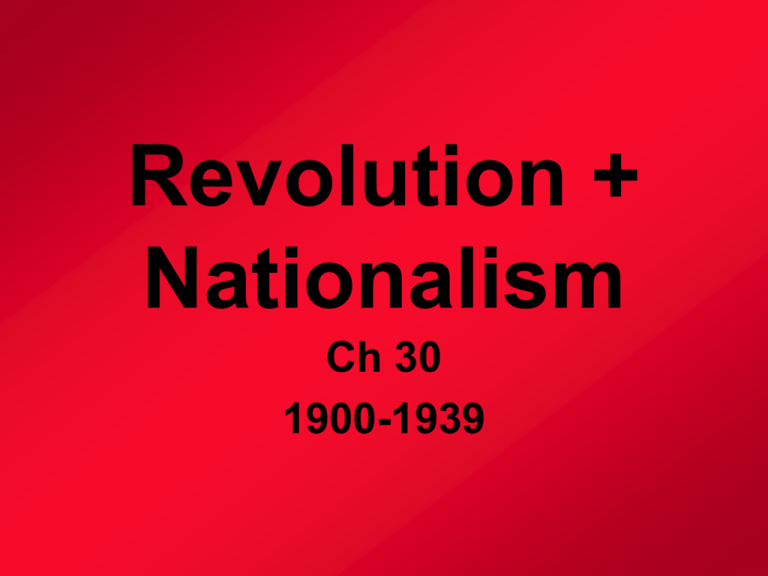
Revolution + Nationalism Ch 30 1900-1939 Russia • Rule of the Czars U.S.S.R. • Russia was an autocracy (a gov.’t in which the ruler has unlimited power + uses it in an arbitrary manner) • Anyone who questioned the czar’s authority, spoke a language other than Russian, or didn’t practice the Russian Orthodox Christian faith was considered dangerous • Jews were especially persecuted • When Czar Nicholas II came into power, Russia was modernizing, but it was still behind Western Europe • He rapidly industrialized Russia • Led to bad living + working conditions which angered many Russians • of the • A group that followed the views of Karl Bolsheviks Marx formed • They believed industrial workers (proletariat) would overthrow the czar • The radical Bolsheviks were willing to sacrifice everything to make that change • Led by Vladimir Lenin “Comrade Lenin Cleanses the Earth of Filth”, a Communist poster from 1920. • Crises Cause the Czar to Lose Support 1. Russo-Japanese War (1904-1905) • Loses angered Russians 2. Bloody Sunday (Jan. 22, 1905) • 200,000 workers + their families marched to the czar’s palace w/ a petition asking for better working conditions, more personal freedoms, + an elected national legislature • Czar’s generals ordered soldiers to fire on the crowd + hundreds died • Provoked violence + so Czar Nicholas II granted more personal freedom + created the Duma (Russian parliament) - which he would later dissolve • 3. WWI – Russians suffered numerous defeats + casualties • 4. Rasputin, a corrupt “holy man” was able to treat Prince Alexis (heir to the Russian throne) for his hemophilia. B/c of that, while the czar was fighting in WWI, the czarina let Rasputin make important political decisions • He was despised by Russians + murdered • The March Revolution • 200,000 workers go out into the streets + protest the gov.’t • Soldiers will side w/ them • Led to revolution + the abdication of Czar Nicholas II (last czar of Russia) • A provisional gov.’t (temporary gov.’t) was established. It was weak + kept Russia in WWI • The Bolshevik • (1918-1920) Lenin returned to Revolution Russia + led the Bolsheviks. They toppled the provisional gov.’t + took over • Signed truce w/ Germany + surrendered a lot of land • Russians angry + civil war breaks out • The Red Army (Lenin’s Bolsheviks) fought against the White Army (Some supported a czarist gov.’t, some wanted democracy, + some were socialists who didn’t like Lenin) • 14 mil Russians die from war + famine • Red Army won • Formation of the U.S.S.R. • Lenin revived economy by establishing a socialist economy (system in which the gov.’t controls major industries) • Lenin ordered the deaths of the czar + his family • Lenin reorganized gov.’ts w/in the country + renames Russia the Union of Soviet Socialist Republics (USSR or Soviet Union) • Bolsheviks rename themselves the Communist Party End Section 1 30.2 Joseph Stalin takes power of USSR after Lenin + establishes a totalitarian state… • Totalitarianism • A gov.’t that takes total, centralized, state control over every aspect of public + private life • Totalitarian leaders appear to provide a sense of security + give direction for the future • Challenges the highest values of Western democracies (reason, freedom, human dignity, + worth of individuals) • Characteristics of a totalitarian gov.’t include: • Police Terror – crush opposition, spy + intimidate, often use brutal methods • Indoctrination – instruction in the gov.’t’s beliefs (control education to glorify the leader, his policies, + establish loyalty) • Propaganda + Censorship – gov.’t controls media + only shows info that reflects positively on the gov.’t (much of it is lies) • Religious or Ethnic Persecution – often create “enemies of the state” (someone to blame for any of the gov.’t’s failures), usually a member of a minority group who are often subjected to campaigns of terror • His secret police monitored phone • Stalin Builds a lines, read mail, + planted informers Totalitarian State everywhere • In 1934, he launched the Great Purge, a campaign of terror to eliminate anyone who threatened his power (real or imagined) • “enemies” were found guilty of “crimes against the state” + sent to labor camps or executed • Controlled all sources of media + the arts – had to glorify Stalin + the USSR • Controlled education from nursery schools to college • Tried to achieve a atheist state by persecuting different faiths (many still clung to their religious beliefs though) • Stalin • Controls the Economy • Proclaimed that USSR was far behind western powers in development + tried to close the gap quickly Established a command economy (system where the gov.’t makes all economic decisions) • Sought to speed up industrialization w/ the 1st 5-year plan (plan for the development of the USSR). It set impossibly high goals for production for items like steel, coal, oil, etc… • Led to shortages of consumer goods, + although most goals weren’t met, many gains were made. • Launched a 2nd 5-year plan w/ similar results • Also sought to control agricultural production • Seized private farms + combined them into large, gov.’t owned farms called collective farms. The crops were given to the state to redistribute • Effects on Society • + Effects: • People became better educated + mastered new technical skills • Women were treated more equally • Many held important jobs (but typically not the best jobs) • - Effects: • Personal freedoms limited, shortage of consumer goods, dissent prohibited • Women, in addition to holding a full time job, were still responsible for all housework + childcare End Section 2 30.3 China • After the • China had suffered years of humiliation by Fall of the foreigners + experiences a in nationalism Emperor • China’s last emperor is overthrown by nationalist gov.’t in 1911 • The Kuomintang (Nationalist Party of China – also known as Guomindang) come into power + establish a republic • Supported modernization + nationalism • The president isn’t strong enough to secure national unity + turns the gov.’t over to a general – chaos ensues • He dies + civil war breaks out • China supports Allies in WWI, but is angry when Treaty of Versailles gives lands it wanted to Japan • Start to turn away from democracy in favor of communism • of 2 Chinese Gov.’ts • The Chinese Communist Party was organized in 1921, one of the founding members was Mao Zedong • He wanted a communist revolution to begin in the country w/ the peasants as the revolutionaries • A new leader in the Kuomintang, Chiang Kai-Shek (or Jiang Jieshi) promised democracy, but his gov.’t became increasingly corrupt + most peasants turn towards Mao’s communists • (1927) Chiang’s Nationalist troops go into Chinese cities + killed many Communist leaders nearly wiping out the Communist Party in China • (1928) Chiang became president of China – surviving Communists enraged • Civil War • By 1930, civil war had broken out • Mao + the Communists base themselves in the countryside + recruit peasants • Frequently attacked by Chiang’s Nationalists, but never defeated • 1933, Chiang + an army of 700,000 surrounded the Communists’ base. 100,000 communists fled + made a 6,000 mi journey called The Long March. • Japanese • While the Communists + Nationalists Invade China are fighting, the Japanese invade Manchuria (NE China) in 1931 – this is the beginning of WWII in Asia • In 1937, Japan launches an all-out invasion of China (known as the 2nd Sino-Japanese War) + would eventually control a large part of China • This would lead to a temporary truce b/w the Communists + the Nationalists as they united to fight the Japanese End Section 3 30.4 • India • • • India + SW Asia Nationalism had been growing since mid 1800s. Many Indians went to British schools + learned European views on nationalism + democracy. They took those ideas home w/ them. 2 groups had formed to promote Indian indep.: 1. Indian National Congress (or Congress Party) – Mostly Hindus 2. The Muslim League During WWI, millions of Indians served in the British Army w/ Britain’s promise of reforms leading to Indian indep. afterwards • Britain didn’t keep its promise + Indian radicals commit acts of violence • Britain passed the Rowlatt Acts (1919) which allowed the gov.’t to jail protestors w/o trial up to 2 yrs • Amritsar Massacre • To protest the Rowlatt Acts, 10,000 Hindu + Muslim Indians gathered at Amritsar + held a festival (non-violent, intended to pray, fast, + listen to political speeches) • Most didn’t know public meetings were banned • British commander thought they were openly defying the ban • British ordered to fire on the crowd w/o warning for 10 min. • 400 Indians died + 1,200 wounded • Immediately after, millions of Indians begin to support the Nationalist movement • British officers responsible weren’t punished • Gandhi • Mohandas Gandhi became the leader of India’s indep. movement • Became known as “Mahatma” (Great Soul) • He urged a policy of noncooperation w/ British gov.’t • (1920) Congress Party endorsed nonviolence + civil disobedience (deliberate + public refusal to obey an unjust law) to achieve indep. • He called on Indians to refuse to attend gov.’t schools, not to pay British taxes, + boycott British goods esp. cloth which was very important to the British. He encouraged Indians to make their own cloth. • (1930) He organized The Salt March in which he + his followers walked 240mi to the sea to make their own salt by collecting seawater + letting the water evaporate rather than buying salt + paying the British salt tax • They then marched to a saltworks where the British processed salt, intending to shut it down but were brutally attacked by police • Gandhi + 60,000 others were arrested • (1935) Britain passed the Gov.’t of Indian Act which allowed local selfgov.t’ but not total indep. • Turkey• • Formerly Ottoman Empire, lost territory after WWI 1919, Greeks invade Turkey but were defeated by Turkish Nationalists led by Mustafa Kemal. • He then overthrew the sultan + became 1st president of the Republic of Turkey-1st republic in SW Asia • • • To modernize Turkey he: 1. Separated laws of Islam from laws of state 2. Abolished religious courts + created a legal system based on European law 3. Gave women right to vote + hold public office 4. Gov.’t funded industrialization He also required Turks to dress in a more western manner + changed the alphabet from Arabic to Latin Kemal given the name Ataturk (Father of the Turks) • Iran • Persia had been divided into British + Russian spheres of influence • Britain tried to take over all of Persia during the Russian Revolution • Triggered a Persian nationalist revolt • Persian army officer Reza Pahlavi seized power • To modernize his country he: 1. Established public schools 2. Built roads + RRs 3. Promoted industrialization 4. Extended women’s rights - But he kept all the power • He changed Persia’s name to Iran • Saudi Arabia • In 1902, Abd Al-Aziz Ibn Saud unified Arabia + renamed it the Kingdom of Saudi Arabia after his family • Carried on Islamic traditions • Modernization was limited to religiously acceptable areas • No efforts to practice democracy were made End Section 4

